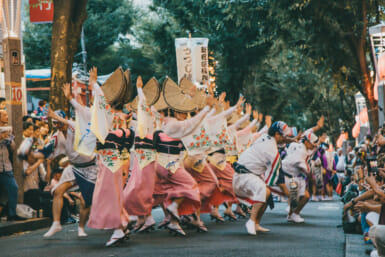HOW TO JAPAN
Books abound advising us on how to survive and flourish in an increasingly complicated world.
The New York Times, which for centuries published the Best Sellers list in two categories, Fiction and Nonfiction, has had to add a third category—Advice, How-to and Miscellaneous. The action was prompted by the fact that the How-to books—ranging in scope from the mysteries of marital joy to the mechanics of Chinese cookery—were crowding everything else off the Nonfiction lists.
Inevitably, the How-to literary industry has zeroed in on Japan. The books are easy to spot at a distance: the covers, for some reason, are either red or yellow and usually feature a rising sun, a rendering of Mt. Fuji, a geisha, or a spectacular combination of all three.
We are treated, in these works, to sophisticated analyses of Things Japanese. Since statistics are readily available on life in Dai Nippon (“The Ministry of Health reports that 67.5% of the population is always happy between 6 and 9 p.m. except Tuesdays.. .”), there are in these books marvelous charts and graphs.
Motives within motives (within motives) are explored. Theories are presented. Conclusions are drawn. (A personal favorite is the Oriental rice culture versus the Western hunter/gatherer explanation of behavioral patterns. It’s so neat.)
Similes are particularly creative. “Understanding Japan is like peeling an onion. When one layer is finished, there is a similar but different layer beneath.” Hey, that’s O.K. Tears aren’t mentioned, but someday someone will work that in.
Max Danger, Ex-pat, suggests that we may be getting ahead of ourselves, however. There are some very basic points about life in Japan which must be covered first.
As a community service, Max presents the following. Scholars frequently miss these things, and God knows ex-pats need all the help they can get.
How to recognize “no” when you hear it:
1. The Japanese word for “maybe.”
2. The Japanese phrase for “we understand.”
How to recognize “yes” when you hear it:
1. The Japanese word for “maybe.”
2. The Japanese phrase for “we understand.”
How to get home from the Ginza at 11:30 p.m.
1. Walk.
2. Wait until 1:30 a.m. and take a taxi.
How to lead the Head Office into thinking your Japan tour is reaching its conclusion:
Begin answering their telexes in Japanese.
How to demonstrate to the Head Office that your Japan tour should be extended:
Begin referring to the guys at MTTI as Chuck, Ted, Mike-san.
How to make a positive impression on your Japanese employees:
Call in sick several times a month.
How to make a negative impression on your Japanese employees:
Never get sick and stay in the office until they all go home.
How to make a positive impression on your Japanese neighbors:
Make a lot of noise, preferably mixed with choruses of “I Did It My Way,” when you arrive home after midnight.
How to spend time with your teenage children:
Go out drinking with the staff after work and show up with a bunch of girls named Yuki at a Roppongi disco.
How to avoid being invited to employee weddings:
Rent a weekend beach house in Kamakura for $2,000 a month and let it be known you always go there.
How to avoid spending $2,000 a month for a weekend beach house in Kamakura:
Fly to Guam—it’s cheaper.
How to recognize a car belonging to a foreigner:
- No doilies on the seats.
- No tissue box on the back shelf.
- No danglies on the rear view mirror.
- No Disneyland bumper stickers.
- No huggable stuffed animals on the dashboard.
- No polish on the exterior.
How to tell a fashionable male Japanese college student from a fashionable female Japanese college student from the rear:
You can’t. (In fact, being in front doesn’t always help.)
How to spend a quiet Sunday dozing in a comfortable chair:
Get into your car and enter any expressway.
How to throw bar hostesses off your trail:
Use only the business cards of new acquaintances which you’d otherwise just file.
How to file business cards of new acquaintances:
Pile them neatly in the upper left corner of your desk drawer until the pile tips over. Then throw them away. How to eat natto:
Don’t
How to frame a time reference for actions involving Japanese courts of law:
Think of your future grandchildren and their descendants.
How to guess the age of a Japanese individual:
- If you think the person is 20, add five.
- If you think the person is 30, add ten.
- If you think the person is 40, add fifteen.
- If you think the person is 50, add twenty.
- There are no 60 year-olds in Japan; they’re either 59 or 89.
How to distinguish a drinker from a genuinely embarassed individual:
The drinker blushes and embarassed individual laughs.
How to confuse a cab driver:
Give directions to him in Japanese.
How to impress a Head Office Visitor:
- Never use a company car. Explain that Ohtemachi and Azabu are hours apart on surface routes. Try to make the subway trips during rush hour.
- Make certain the waiter at Tour D’Argent gives the Visitor the menu with prices during the little “snack after work.”
- Convert all American Club prices into U.S. dollars for the benefit of your Visitor.
- Tell the Visitor you took three days off once last year in order to play one round of golf.
- Throw your head back and laugh—let it loose— when he suggests a game of tennis.
- Explain that there are 13 ways to count from one to ten in Japanese.
- Pray for a moderate earthquake (4.0 on the Richter scale, and whatever the hell it is on the Japanese scale.)
How to deal with your situation in the Land of the Rising Sun:
Thank Whomever you thank that you’re not in Cleveland.








